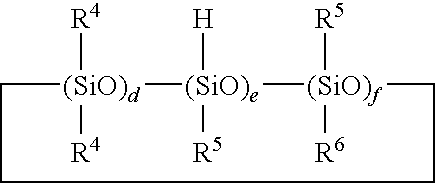Rubber stopper composition and medical rubber stopper
- Summary
- Abstract
- Description
- Claims
- Application Information
AI Technical Summary
Benefits of technology
Problems solved by technology
Method used
Image
Examples
examples
[0086]The present invention will be described below more in detail with reference to Examples. It should be noted that the present invention is not limited to these Examples, but may be changed unless the gist of the present invention is changed.
[0087]The molecular weight of each of the components (A) and (E) of the present example, the number of terminal allyl groups of each of the components (A) and (E), the styrene content of each of the components (A) and (E), and the properties of a rubber stopper composition and rubber stopper were measured according to the following methods.
(Molecular Weight)
[0088]A GPC system manufactured by Waters (column: Shodex K-804 (polystyrene gel) manufactured by Showa Denko K.K., mobile phase: chloroform) was used, and the weight-average molecular weight was based on polystyrene.
(Number of Terminal Allyl Groups)
[0089]The 1H-NMR of a solution obtained by dissolving an isobutylene-based polymer in deuterated chloroform was measured, and the number of t...
example of production 1
(A) Isobutylene-Based Polymer Having an Alkenyl Group at a Terminal thereof (hereinafter Abbreviated as “APIB”)
[0122]Nitrogen substitution was performed with a three-way cock, a thermocouple, and a stirring seal attached to a 2 L separable flask. After the nitrogen substitution, the three-way cock was used to cause nitrogen to flow. A syringe was used to add 785 ml of toluene and 265 ml of ethyl cyclohexane thereto. The 2 L separable flask was cooled down to approximately -70° C. After the cooling, 277 ml (2933 mmol) of an isobutylene monomer were added. After the 2 L separable flask was cooled down again to approximately −70° C., 0.85 g (3.7 mmol) of p-dicumylchloride and 0.68 g (7.4 mmol) of picoline were added by being dissolved in 10 ml of toluene. At the point of time where the internal temperature of the reaction system was stabilized at −74° C., polymerization was started by adding 19.3 ml (175.6 mmol) of titanium tetrachloride. After the polymerization reaction had been fini...
example of production 2
(E) Isobutylene-Based Block Copolymer, Triblock Structure having a Styrene Content of 15% (hereinafter Abbreviated as “SIBS1”)
[0123]After a gas contained in a 500 ml separable flask serving as a polymer container was replaced with nitrogen, 21.2 ml of n-hexane (dried by a molecular sieve) and 256.6 ml of butyl chloride (dried by a molecular sieve) were added thereto with use of a syringe. The polymer container was cooled down in a −70° C. dry ice / methanol bath. After that, a Teflon (registered trademark) solution-sending tube was connected to a three-way-cock-equipped pressure-proof glass liquefaction collection tube containing 60.5 mL of an isobutylene monomer, the isobutylene monomer was sent to the polymer container by nitrogen pressure. After 0.120 g of p-dicumylchloride and 0.121 g of N,N-dimethylacetamide had been added, polymerization was started by further adding 1.02 mL of titanium tetrachloride. After 75 minutes of agitation after the start of the polymerization, 8.02 g of...
PUM
| Property | Measurement | Unit |
|---|---|---|
| Percent by mass | aaaaa | aaaaa |
| Percent by mass | aaaaa | aaaaa |
| Percent by mass | aaaaa | aaaaa |
Abstract
Description
Claims
Application Information
 Login to View More
Login to View More - R&D
- Intellectual Property
- Life Sciences
- Materials
- Tech Scout
- Unparalleled Data Quality
- Higher Quality Content
- 60% Fewer Hallucinations
Browse by: Latest US Patents, China's latest patents, Technical Efficacy Thesaurus, Application Domain, Technology Topic, Popular Technical Reports.
© 2025 PatSnap. All rights reserved.Legal|Privacy policy|Modern Slavery Act Transparency Statement|Sitemap|About US| Contact US: help@patsnap.com

